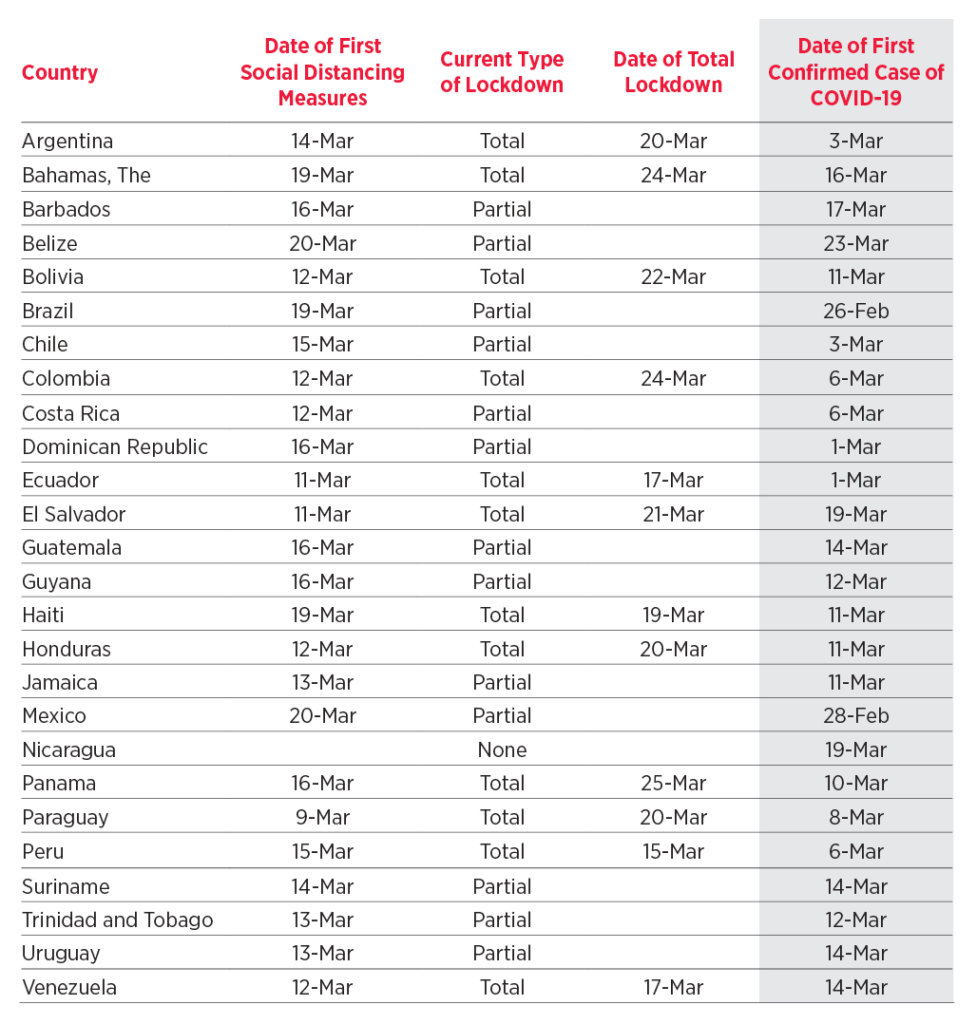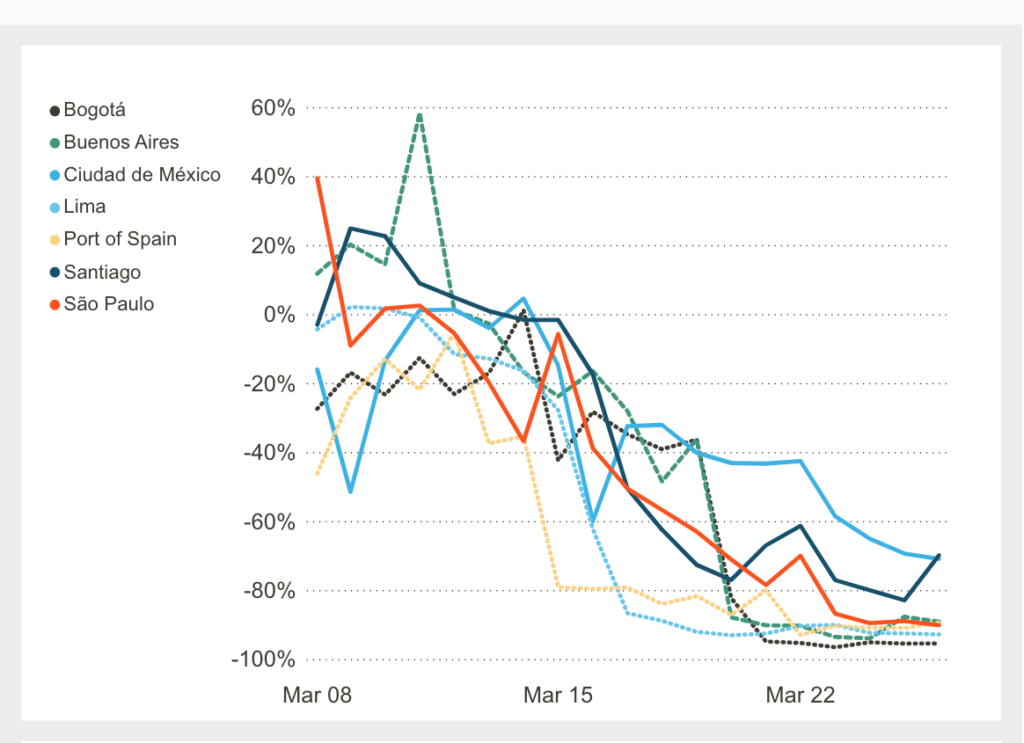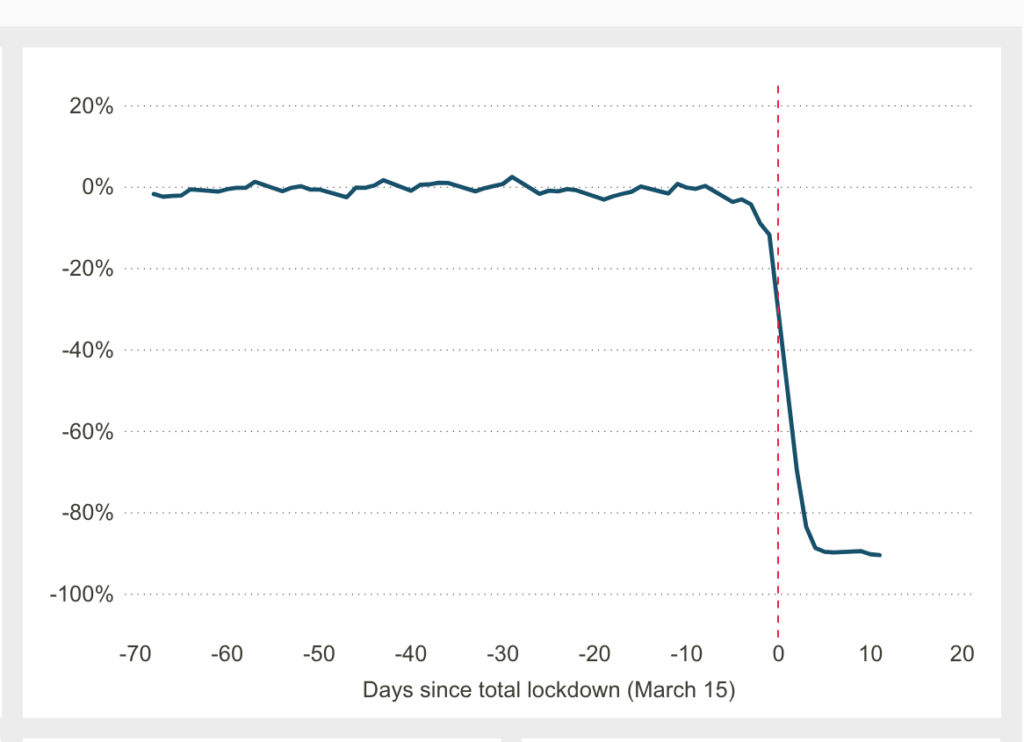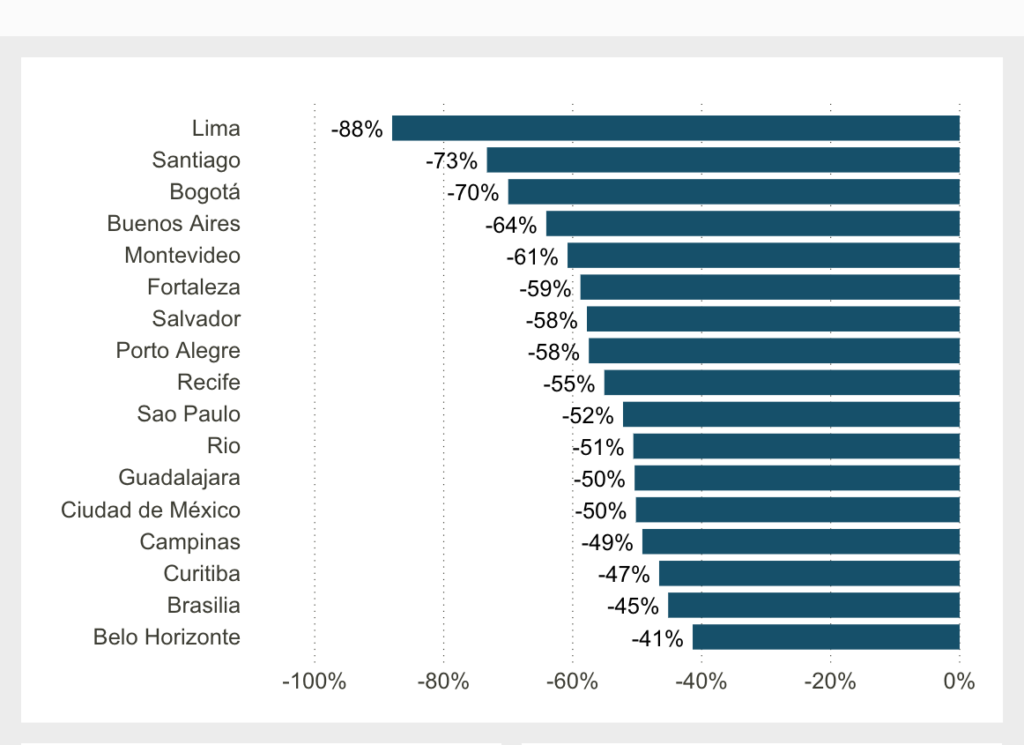Coronavirus Impact Dashboard: The Effects of Social Distancing Measures

Read this article in Spanish or Portuguese.
Life as we know it has changed drastically and seemingly overnight as a result of the coronavirus. Measures are being taken to slow the exponential rise of infections and reduce pressure on the capacity of health systems to care for the sick. In the past few weeks, many countries have ramped up efforts to adopt social distancing measures such as closing schools, limiting large gatherings, and shutting borders. More recently, some countries have implemented total lockdowns, stay-at-home orders, and closures of all non-essential businesses.
Since the coronavirus disease (also known as COVID-19) has hit Latin America and the Caribbean later than other regions, early and effective adoption of social distancing measures could be a game changer. The region still has a chance to flatten the curve of infection. Today, almost all countries in the region have adopted some sort of social distancing measures and more than 10 have declared total lockdowns (see Table 1 for details).
But do we know if social distancing measures are truly working? What impact will these measures have on helping Latin America and the Caribbean cope with the coronavirus?
Table 1. Dates of First Cases of COVID-19 and Implementation of Related Social Distancing and Lockdown Measures in Latin America and the Caribbean

Note: Information as of March 25th, 2020.
The IDB and IDB Invest have joined forces to launch the Coronavirus Impact Dashboard to track the real-time impact of the coronavirus on countries in the region. The dashboard tracks a range of variables in order to provide Latin American and Caribbean policymakers, epidemiologists, and the general public with measures of the impact of the coronavirus outbreak on people’s behavior and economic activity.
The first release of the dashboard includes daily data on infection cases and deaths as well as proxies for social distancing such as changes in the intensity of traffic congestion and the use of public transportation. As the crisis evolves, we will be continuously updating the data and adding variables to help understand and combat the impact of the coronavirus in the region.
Why look at traffic congestion? Changes in traffic congestion patterns can help measure the extent of social distancing by capturing people’s mobility decisions, as well as variations in economic activity. According to an INRIX report, traffic can be an indication of a healthy economy because it measures people going to work and the movement of commerce. While the capacity of a road is generally constant (unless it is upgraded or expanded), the numbers of people and commerce that transit a road fluctuate in part according to economic activity.
Data for the dashboard on traffic congestion comes from our partnership with Waze, a community-driven navigation app. As part of this collaboration, we receive real-time aggregated geocoded data on traffic conditions and alerts reported by Waze users from across Latin America and the Caribbean every two minutes. Using this data, we constructed a Traffic Congestion Intensity measure (see details here) to capture daily variations and measure them against a baseline period. We designated the week of March 1–7, 2020 as the baseline because during that week traffic patterns were not affected by regional holidays (e.g., carnival, summer school recess) and there were still very few reported coronavirus cases in the region. In addition, social distancing restrictions or recommendations had yet to be issued by governments.
Data shows that Traffic Congestion Intensity in the region has declined significantly since the beginning of the crisis as depicted in Figure 1. On average, for the period March 8 to 26, congestion in the metropolitan areas of Bogota, Buenos Aires, Lima, Mexico City, Port of Spain, São Paulo, and Santiago dropped, by 34% to 63%, with the largest decrease observed in Port of Spain and the smallest in Mexico City (see the dashboard for more metropolitan areas and country-level data). Interestingly, in the week up to March 15, when almost no country had yet implemented social distancing measures, congestion was already lighter than usual in several metropolitan areas, with the largest declines observed in Port of Spain (33%) and Bogota (20%).
Figure 1. Changes in the Traffic Congestion Intensity in Select Latin American and Caribbean Metropolitan Areas (percent change)

Note: Percentage change measured against the week of March 1-7. Based on data from Waze for cities. Source: IDB and IDB Invest Coronavirus Impact Dashboard
It is clear that people’s behavior is changing rapidly. While this may be partly explained by fear, a desire to avoid contagion, or a personal commitment to help reduce spread of the disease, the most extreme responses seem to be driven by government-imposed measures. For example, a sharp decline in Traffic Congestion Intensity started in the week of March 16, by which time almost all countries in the region had implemented some sort of social distancing measure. Metropolitan areas that stand out are Lima (86% decrease) and Port of Spain (83% decrease). While it may be too soon to determine the full impact of total lockdowns and other measures, by March 26th Bogota, Buenos Aires, Lima, Port of Spain and São Paulo had seen a decrease in Traffic Congestion Intensity of around 90% or more.
Analysis of public transport data suggests similar patterns. Figure 2 shows data from usage of the Metropolitano Bus Rapid Transit (BRT) system in Lima, where ridership decreased by around 80% compared to typical levels. Also, data from Moovit, an urban mobility app, shows decreases in public transport use ranging from 41% to 88% in cities across Latin America (Figure 3).
Figure 2. Change in Public Transport Use on the Metropolitano BRT Line, Lima, Peru

Note: Percentage change is measured against the week of January 15th. Data from Municipality of Lima.
Figure 3. Change in Public Transport Ridership in Select Latin American Cities according to Moovit

Note: Percentage change from week of January 15 to March 26, 2020. Data from Moovit. Source: IDB and IDB Invest Coronavirus Impact Dashboard
Other analyses have also begun to approximate the effect of social distancing in the region. A recent IDB blog showed how Google searches for “Netflix” have exploded in most countries in Latin America and the Caribbean (47% on average), while searches for “cinema” (-42%) and “restaurant” have dropped sharply (-34%), a reflection that people are increasingly staying at home.
These analyses are not just academic curiosities, we believe that monitoring the effects of social distancing is very important. There is evidence from previous outbreaks, including the 1918 flu pandemic and the 2014 Ebola outbreak, that social distancing can effectively limit the spread of infection. The restrictions governments are imposing worldwide reflect a consensus that these are painful but necessary actions. Providing evidence on where and when these restrictions are working well (or not) can guide immediate policy responses that could save lives.
In the weeks to come, we will likely start seeing other impacts beyond those on traffic. We invite governments and companies collecting high-frequency data to partner with us on the Coronavirus Impact Dashboard so that we can continue increasing awareness of the effects of the coronavirus and help disseminate this information to Latin America and the Caribbean.
These are challenging times for countries across the world, but the effects of the coronavirus could potentially be worse in developing countries where limited health infrastructure and economic inequalities are cause for concern. Making sure that citizens in Latin America and the Caribbean stay at home and strictly follow social distancing recommendations could truly make a difference in the region’s capacity to cope with this pandemic.■
LIKE WHAT YOU JUST READ?
Subscribe to our mailing list to stay informed on the latest IDB Invest news, blog posts, upcoming events, and to learn more about specific areas of interest.
Subscribe



